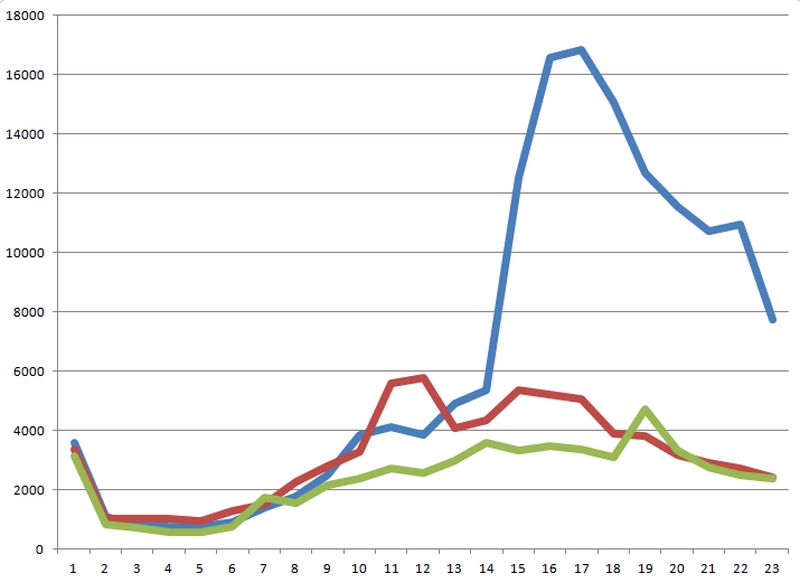
A Day of Protest
It began September 17, 2011. It did not start with huge crowds. One of the Twitter messages on the 30th was "Hey man, I remember when #OccupyWallStreet was small and "insignificant."" It did start small. They adopted the hashtag #OccupyWallStreet" and they started camping in the park.
But it grew in size and enthusiasm. One way to observe the attention it was getting is counting Twitter messages that contained the hashtag. The increase in the number of Twitter messages was roughly parallel to the growth in the number of people participating in the protest.
If your lense is 24 hours here are three numbers.
September 29 |
September 30 |
October 1 |
55,263 |
72,952 |
150,381 |
Growth by a third from the 29th to the 30th. Then just over a 100% jump. That may be all you want to know.
But you can look at the numbers of Twitter messages by the hour; a finer lense. The results are presented in the figure.
 |
The green line is September 29, the red line is September 30, and the blue line is October 1. The hours are for a 24 hour clock and mark the x axis.
It is striking how close the numbers are until 9:00 or 10:00. The hour from midnight the day before to 1:00 they show a parallel drop. People go to bed. Messaging slows through the very early morning then begins to pick up. All three are increasing from 6:00 to 7:00 to 8:00 to 9:00.
At 9:00 there is some separation. The number of messages did not increase for September 29 as rapidly as it did for the 30th and October 1. The number of messages then grew somewhat more quickly on the 29th than on the 1st.
All are in roughly the same range until 15:00. At that point there is a huge jump in messaging on October 1. It continues up with 16:00 and 17:00 the peak for the day with just over 16,000 messages each hour. It falls after 17:00, but it never falls even close to the level of messaging on the 29th and 30th.
So what happened between 15:00 and 16:00 to produce the jump?
15:09 amyrnbsn WooHoo! Go Brooklyn! Go #OccupyWallStreet! RT @jopauca: Brooklyn bridge now belongs to #OccupyWallSt #OccupyWallStreet http://t.co/EGgd7S9s
And at 15:18
15:18 ty_ushka They are arresting marchers who are on the road #occupywallstreet
The police acted. The marchers were crossing Brooklyn bridge -- in very large numbers. And the police arrested them -- also in very large numbers. According to the New York Times and CBS News approximately 700 were arrested.
The upshot was a burst of enthusiasm for the protest.
One interpretation is: the police, whose pensions are being dragged down by Wall Steet traders, knew that large scale arrests would lead to more intense protest. If the protest became intense enough it might have an impact on government and traders. And the police pensions might improve as a result.
Well, that is only one interpretation. Surely concocted by someone writing too late in the early morning. On the other hand, I may not have been the only one to imagine such
MarkAGossett RT @OfficialRabbits An #NYPD Officer in plain clothes flashes his badge and told a staff member we do support you & not to stop.
Either an officer or a person tweeting could come up with the same story.
The point, however, is to note the impact of police action. It did not quell the protest. Everywhere that police attempt to quell protest -- reduce to submission, as the dictionary defines -- it has the opposite effect. It does not seem to matter if it is in Syria or Wall Street. If the starting point is a high level of commitment police action is counterproductive if you want to quell protest.
At least, that is what the numbers suggest.
@G. R. Boynton, October 2, 2011